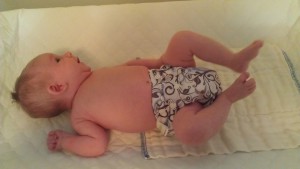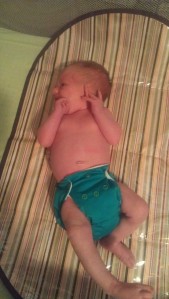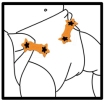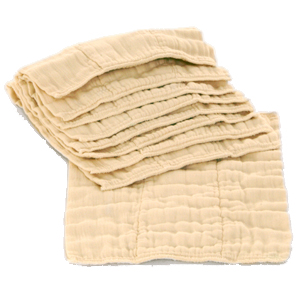If someone would have told me months ago that I was going to have a 5lb full term baby, I seriously would have laughed in their face. After all I felt huge! I had all of these great all in ones, pockets, and prefolds prepped and ready to use for when my daughter arrived. None of them would fit.
I went in to my normal doctor’s appointment at 39 weeks pregnant only to be rushed down to ultrasound because I was suddenly measuring too small. Up until then Ham was healthy and measuring normal. Instead I ended up delivering a 5 pound baby. I was expecting at least a 6 pound infant, but instead had to send out my mother in law to buy preemie clothing just so I could take her home in something she wasn’t swimming in.
After all the merconium was out of her system I was ready to use my cloth diapers. I had no idea which ones would actually fit. Not a single “One Size” would fit my 5 pound baby. All of my One Size diapers were completely useless until Ham reached almost 10lbs. There went all my cute pockets and all in ones that I had been waiting anxiously to use. Even my infant sized prefolds weren’t meant to fit a baby that small.
I ended up finding a few different newborn diapers that did fit, but they were few in far between. I started with OsoCozy Newborn Prefolds. I was able to tri-fold these and place them in the Thirsties Duo Covers. I was so excited that the Thirsties covers would fit my tiny baby. We never had a single leak using this system and she still fits in the Thirsties Covers even now at almost 12lbs. I’m now using the Infant Size OsoCozy prefolds, but this system truly fits a newborn. This was also the most economically priced cloth diaper system we used.
As for all in ones and pockets we had two that really fit her from 5-8lbs. The Blueberry Newborn Simplex diapers are adorable as you can see below. They were also the trimmest of the diapers we found that fit. The Newborn Simplex use birdseye material which is the same material flat diapers are made of. They were a cinch to put on and dry extremely quick. I believe these would even fit a 2-3lb preemie and they come in the cutest prints and colors.
The other all in one that fit super well was the Rumparooz Lil Joeys. These are absolutely perfect for a newborn or preemie. They even had the umbilical snap which is super rare in an all in one diaper. They have inner gussets so we also never had a leak or blowout. So many of the diapers were just too large at birth, but I feel this is a diaper that will truly fit a newborn and you don’t need to add any extra inserts for absorption.
You can’t lose with newborn prefolds or flats. These cloth diapering systems are economical and will most definitely fit your newborn even if they look a little bulky at first. However, if you are going to go the One Size diaper route please make sure you are aware that those may not fit for quite some time. Newborn sized pockets and all in ones will work, but then you are stuck with having to buy a size that may only last 2 months. Ham is 2.5 months now and is just now comfortably fitting into many of the One size diapers at 11 pounds. It sounds silly but One Size isn’t really one sized.









